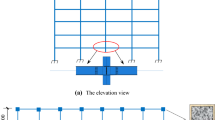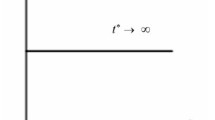Abstract
A 9-story concrete-filled steel tubular frame model is used to analyze the response of joints due to sudden column loss. Three different models are developed and compared to study the efficiency and feasibility of simulation, which include substructure model, beam element model and solid element model. The comparison results show that the substructure model has a satisfying capability, calculation efficiency and accuracy to predict the concerned joints as well as the overall framework. Based on the substructure model and a kind of semi-rigid connection for concrete-filled square hollow section steel column proposed in this paper, the nonlinear dynamic analyses are conducted by the alternate path method. It is found that the removal of the ground inner column brings high-level joint moments and comparatively low-level axial tension forces. The initial stiffness and transmitted ultimate moment of the semi-rigid connection are the main factors that influence the frame behavior, and their lower limit should be guaranteed to resist collapse. Reduced ultimate moment results in drastic displacement and axial force development, which may bring progressive collapse. The higher initial stiffness ensures that the structure has a stronger capacity to resist progressive collapse.
Similar content being viewed by others
References
ASCE. SEI/ASCE7-05. Minimum Design Loads for Buildings and Other Structures[S]. American Society of Civil Engineers, Washington DC, 2005.
Fu Feng. Progressive collapse analysis of high-rise building with 3-D finite element modeling method[J]. Journal of Constructional Steel Research, 2009, 65(1): 1269–1278.
Hu Xiaobin, Qian Jiaru. Overview of analysis and design approaches for progressive collapse of structures[J]. Building Structure, 2006, 36(Suppl): 79–83 (in Chinese).
Saad A, Said A, Tian Y. Overview of progressive collapse analysis and retrofit techniques[C]. In: The Proceedings of the 5th International Engineering and Construction Conference (IECC’5). California, USA, 2008. 765–772.
Guo W, Gilsanz R. Simple nonlinear static analysis procedure for progressive collapse evaluation[C]. In: The Proceedings of Blast and Progressive Collapse Symposium. New York, USA, 2003. 97–106.
Izzuddin B A, Vlassis A G, Elghazouli A Y et al. Progressive collapse of multi-storey buildings due to sudden column loss-Part I: Simplified assessment framework[J]. Engineering Structures, 2008, 30(5): 1308–1318.
BS 5950. Structural Use of Steelwork in Buildings, Part 1: Code of Practice for Design—Rolled and Welded Sections[ S]. London, 2001.
Draft prEN 1991-01-07. Eurocode 1-Actions on Structures, Part 1-7: General Action-Accidental Actions[S]. European Committee for Standardization, Brussels, 2005.
General Service Administration. Progressive Collapse Analysis and Design Guidelines for New Federal Office Buildings and Major Modernization Projects[S]. 2003.
US Department of Defense. Unified Facilities Criteria: Design of Buildings to Resist Progressive Collapse[S]. UFC 4-023-03, 2005.
Japanese Society of Steel Construction Council on Tall Buildings and Urban Habitat. Guidelines for Collapse Control Design, Part I, Design[S]. 2005.
Han Linhai. Concrete Filled Steel Tubular Structure — Theory and Practice[M]. Science Press, Beijing, 2007 (in Chinese).
Zhong Shantong. Unified Theory of Concrete Filled Steel Tube—Research and Application[M]. Tsinghua University Press, Beijing, 2006 (in Chinese).
Lee C H, Kim S, Han K H et al. Simplified nonlinear progressive collapse analysis of welded steel moment frames[J]. Journal of Constructional Steel Research, 2009, 65(5): 1130–1137.
Eurocode 3: Design of Steel Structures, Part1. 8 Design of Joints[S]. European Committee for Standardization, Brussels, 2003.
Author information
Authors and Affiliations
Corresponding author
Additional information
Supported by National Natural Science Foundation of China (No. 50878066), Natural Science Foundation of Heilongjiang Province (No. ZJG0701) and Heilongjiang Postdoctoral Science Foundation.
XU Man, born in 1982, female, doctorate student.
Rights and permissions
About this article
Cite this article
Xu, M., Zhang, S., Guo, L. et al. Progressive collapse analysis of concrete-filled steel tubular frames with semi-rigid connections. Trans. Tianjin Univ. 17, 461–468 (2011). https://doi.org/10.1007/s12209-011-1672-7
Accepted:
Published:
Issue Date:
DOI: https://doi.org/10.1007/s12209-011-1672-7




